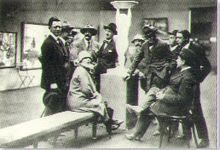Jacqueline Marval
Jacqueline Marval , née Marie-Joséphine Vallet (born October 19, 1866 in Quaix-en-Chartreuse, Département Isère , † May 28, 1932 in Paris ) was a French painter of the Parisian avant-garde .
life and work
Marie-Joséphine Vallet came from a family of teachers. She herself trained as a teacher with graduation in 1884 and began to paint under the stage name Marie Jacques . In 1886 she married the sales representative Albert Valentin and divorced in 1891 due to the early death of their baby. Then she earned her living as a vest maker.
In 1894 she met the painter François-Joseph Girot and moved with him to Paris. The following year she met another painter, Jules Flandrin (1871-1947), who was a student of Gustave Moreau . She left Girot and lived with Flandrin in the rue Campagne-Première in the Quartier du Montparnasse . Under his influence, she decided to become a painter. She lived with him for 20 years.
Vallet's first works were rejected by the Salon des Indépendants in 1900. A year later, in 1901, she was able to exhibit ten of her own paintings there under the stage name Jacqueline Marval . The art dealer Ambroise Vollard acquired them in full.

In 1902 some of her works were exhibited alongside those by Flandrin, Albert Marquet and Henri Matisse in Berthe Weill's small gallery in rue Massé. Weill was particularly interested in sponsoring women artists who lived in Paris. In 1905 she presented at the Salon d'Automne the image Le Printemps made; it hung in an adjoining room of room VII, which the art critic Louis Vauxcelles called "Cage aux fauves" on the occasion of the exhibition . The avant-garde images presented there and a contrasting, classic-looking sculpture, created by Albert Marque , coined the term Fauvism . The photo opposite shows her in this room with artist friends.
In 1911, Marval was selected by a jury consisting of Gabriel Astruc , Antoine Bourdelle and the painters Maurice Denis and Édouard Vuillard to decorate the foyer of the new Théâtre des Champs-Élysées . She created a series of twelve paintings on the theme of Daphnis and Chloe , which she completed in 1913. In the same year, she appealed against the removal of Kees van Dongen's painting Nu au pigeon from the Salon d'Automne. She became friends with the artist and set up her own studio near van Dongen's studio.
Francis Picabia selected her painting Les Odalisques for the avant-garde exhibition at the Armory Show , which was held in New York in 1913 . In the following year Guillaume Apollinaire stated in Chronique des arts : "Madame Marval a donné la mesure de son talent et réalise une œuvre importante pour la peinture modern."
In July 1916, the poet André Salmon organized an exhibition in the Salon d'Antin in the Barbazanges Gallery , in which the Odalisques could be seen near the painting Les Demoiselles d'Avignon by Pablo Picasso , which was first exhibited there .
Jacqueline Marval was now known in Europe. She exhibited in Basel, Barcelona, Oslo, the Venice Biennale, Winterthur and Zurich. She later lost interest in painting, turned to dancing with dyed red hair and fancy clothing (including green hats from her own manufacture), which led to the nickname fée de la Belle Époque .
After Marval's death in 1932, her works were permanently exhibited at Galerie Druet until it closed in 1938.
painting
- L'Odalisque au guépard , 1901
- Les Odalisques , 1902/03
- L'Espagnole , 1904
- Danseuses , 1909
- Homage to Gérard de Nerval , 1912
- Repose , 1912
literature
- Catherine Gonnard and Élisabeth Lebovici: Femmes / Artistes, artistes femme. Paris, de 1880 à nos jours . Editions Hazan, Paris 2007, pp. 67/68
- Gillian Perry: Women artists and the Parisian avant-garde: modernism and feminine art, 1900 to the late 1920s . Manchester University Press, Manchester 1995, ISBN 0-7190-4165-1
- François Roussier: Jacqueline Marval, 1866–1932 . Thalia Édition, Paris 2008, ISBN 978-2-35278-040-3
- Maurice Wantellet: Le Dauphiné et les peintres, une source d'inspiration. éditions Le Dauphiné libéré
- Maurice Wantellet: Deux siècles et plus de peinture dauphinoise . Grenoble 1987, ISBN 2-9502223-0-7
Exhibitions
- 1989: Jacqueline Marval (1866–1932): a Retrospective Exhibition , Crane Kalman Gallery, London
- 1995: François Joseph Girot, Jacqueline Marval, Jules Flandrin, Lucien Mainssieux: les années 1895–1916 , Musée Mainssieux, Voiron
- 2007: Les Femmes peintres et l'avant-garde, 1900–1930 in the Musée Paul-Dini de Villefranche sur Saône showed the works of four women: Suzanne Valadon (1865–1938), Jacqueline Marval (1866–1932), Émilie Charmy ( 1878–1974) and Georgette Agutte (1867–1922).
Web links
- Website Jacqueline Marval
- Works by Marval in the French database Base Joconde
Individual evidence
- ^ Jacqueline Marval , papillongallery.com
- ↑ Chris Petteys: Dictionary of Women Artists , GK Hill & Co. publishers, 1985
- ↑ Attribution of the persons: see picture source
- ↑ exhibitions , jacqueline-marval.com
- ↑ Milton W Brown: The Story of the Armory Show ' , The Joseph H. Hirshhorn Foundation, 1963, p. 242
- ^ Edition of April 5, 1914
- ^ Biography of Jacqueline Marval . cranekalman.com
- ↑ Les Femmes peintres et l'avant-garde, 1900–1930 , lanutrition.fr
| personal data | |
|---|---|
| SURNAME | Marval, Jacqueline |
| ALTERNATIVE NAMES | Marie-Joséphine Vallet (maiden name) |
| BRIEF DESCRIPTION | French painter |
| DATE OF BIRTH | October 19, 1866 |
| PLACE OF BIRTH | Quaix-en-Chartreuse, Isère department |
| DATE OF DEATH | May 28, 1932 |
| Place of death | Paris |



